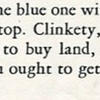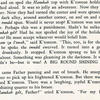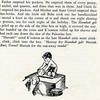7: Excerpts from children’s book, Sadie Rose Weilerstein’s “K’tonton Takes a Ride on a Runaway Trendel” from "The Adventures of K’tonton," 1935.
Sadie Rose Weilerstein’s series of children’s books featuring K’tonton, a thumb-sized mischief-making Jewish boy, are considered landmark works of American Jewish children’s literature, educating young people about Judaism through adventure rather than pure didacticism. The stories, initially published by the Women’s League for Conservative Judaism, brought readers into K’tonton’s upwardly mobile, Americanizing immigrant family, who may have seemed to them quaintly typical of a previous generation of American Jews.
In “K’tonton Takes a Ride on a Runaway Trendel,” K’tonton is eager to collect Hanukkah gelt to add to his collection for the iconic blue box of the Jewish National Fund, an organization that educated Jews toward Zionism and encouraged them to contribute money to purchase land in Eretz Yisrael. When his family forgets to give him Hanukkah gelt, he accidentally winds up riding a runaway trendel—a synonym for "dreidel"—which leads him to a quarter and eventually reminds his family to contribute to his collection.
Suggested Activity: Ask your students: What knowledge does this story take for granted? What do children already need to know about Hanukkah gelt in order to read the story? What attitudes does the author communicate about the relationship between East European Jewish cultural traditions (like Hanukkah gelt) and Zionism? How is this portrayal of the practice of giving Hanukkah gelt similar to or different from the portrayal in other excerpts in this kit?
Source: Sadie Rose Weilerstein, “K’tonton Takes a Ride on a Runaway Trendel,” in The Adventures of K’tonton (The League Press of the National Women’s League of the United Synagogue, 1935), 27, 29, 31.
Weilerstein1.jpg
 Download image (45.61 KB)
Download image (45.61 KB) Weilerstein2.jpg
 Download image (128.3 KB)
Download image (128.3 KB) Weilerstein3.jpg
 Download image (111.39 KB)
Download image (111.39 KB)



